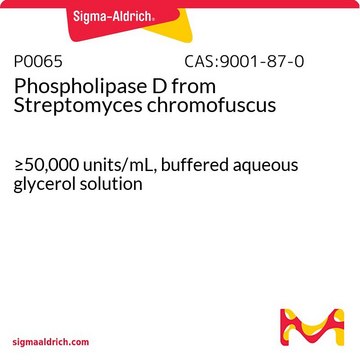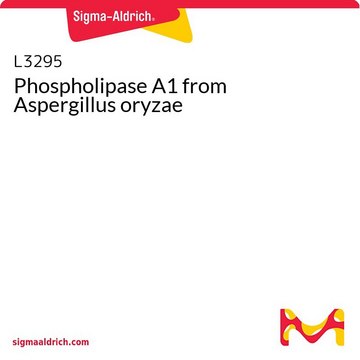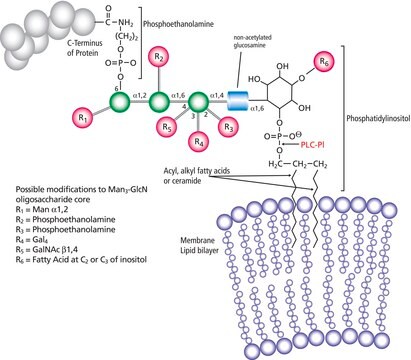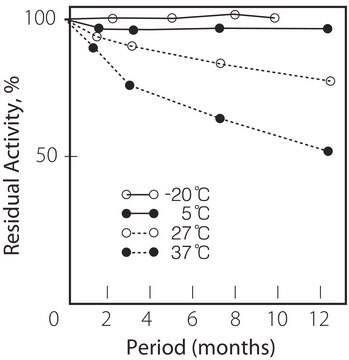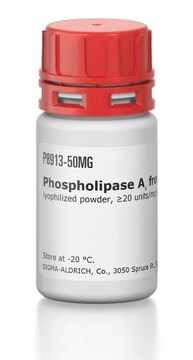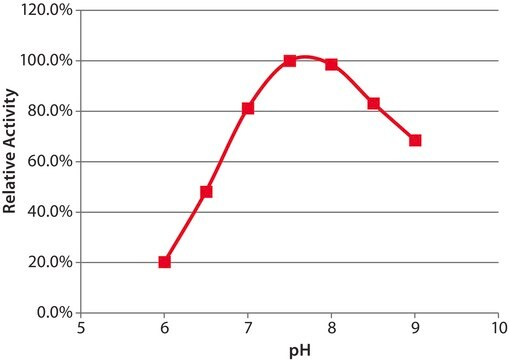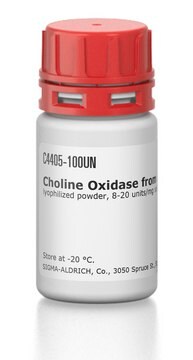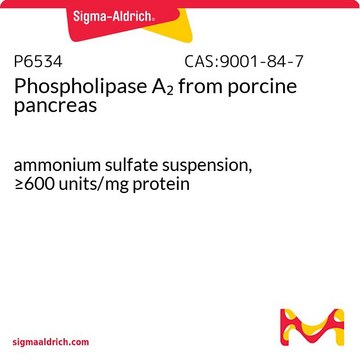Wszystkie zdjęcia(1)
Kluczowe dokumenty
P4912
Phospholipase D from Streptomyces sp.
Type VII, lyophilized powder, ≥150 units/mg solid
Synonim(y):
Lecithinase D, Phosphatidylcholine phosphatidohydrolase
Zaloguj sięWyświetlanie cen organizacyjnych i kontraktowych
About This Item
Polecane produkty
pochodzenie biologiczne
Streptomyces sp.
Poziom jakości
typ
Type VII
Formularz
lyophilized powder
aktywność właściwa
≥150 units/mg solid
temp. przechowywania
−20°C
Zastosowanie
Phospholipase D (PLD) has been used to hydrolyze the phosphate bonds of phospholipids and sphingomyelin to yield the corresponding phosphatidic acid. It has also been used to study metabolic labeling and direct imaging of choline phospholipids in vivo by measuring propargyl-Cho incorporation. Furthermore, PLD has been used in purification and kinetic studies.
The enzyme from Sigma has been used in the translocation of sphingosine kinase 1 (SK1) to membrane fractions under in vitro conditions. It has also been used to produce phosphatidic acid (PA) from phosphatidylcholine (PC) in HL60 permeabilized cells.
Działania biochem./fizjol.
Hydrolyzes the phosphate bonds of phospholipids and sphingomyelin to give the corresponding phosphatidic acid.
Phospholipase D is glycerophospholipid-specific. It is markedly less active on sphingomyelins and lysophospholipids. Phospholipase D hydrolyzes the phosphate bonds of phospholipids and sphingomyelin to give the corresponding phosphatidic acid.
Opakowanie
Bottomless glass bottle. Contents are inside inserted fused cone.
Definicja jednostki
One unit will liberate 1.0 μmole of choline from 1,2-Dioleoyl-sn-glycero-3-phosphocholine per hour at pH 8.0 at 37 °C.
Komentarz do analizy
Protein by biuret
Ta strona może zawierać tekst przetłumaczony maszynowo.
Inhibitor
Numer produktu
Opis
Cennik
Hasło ostrzegawcze
Danger
Zwroty wskazujące rodzaj zagrożenia
Zwroty wskazujące środki ostrożności
Klasyfikacja zagrożeń
Resp. Sens. 1
Kod klasy składowania
11 - Combustible Solids
Klasa zagrożenia wodnego (WGK)
WGK 3
Środki ochrony indywidualnej
Eyeshields, Gloves, type N95 (US)
Wybierz jedną z najnowszych wersji:
Masz już ten produkt?
Dokumenty związane z niedawno zakupionymi produktami zostały zamieszczone w Bibliotece dokumentów.
Klienci oglądali również te produkty
Mohamed H Yaghmour et al.
Journal of lipid research, 62, 100022-100022 (2021-01-17)
Phospholipids with a choline head group are an abundant component of cellular membranes and are involved in many important biological functions. For studies on the cell biology and metabolism of these lipids, traceable analogues where propargylcholine replaces the choline head
Kathryn Garner et al.
The Journal of biological chemistry, 287(38), 32263-32276 (2012-07-24)
Phosphatidylinositol transfer proteins (PITPs) are versatile proteins required for signal transduction and membrane traffic. The best characterized mammalian PITPs are the Class I PITPs, PITPα (PITPNA) and PITPβ (PITPNB), which are single domain proteins with a hydrophobic cavity that binds
Christine Delon et al.
The Journal of biological chemistry, 279(43), 44763-44774 (2004-08-18)
Sphingosine kinase 1 (SK1) phosphorylates sphingosine to generate sphingosine 1-phosphate (S1P). Because both substrate and product of the enzyme are potentially important signaling molecules, the regulation of SK1 is of considerable interest. We report that SK1, which is ordinarily a
Franka Voigt et al.
RNA (New York, N.Y.), 18(12), 2128-2134 (2012-10-23)
Piwi-interacting RNAs (piRNAs) are a gonad-specific class of small RNAs that associate with the Piwi clade of Argonaute proteins and play a key role in transposon silencing in animals. Since biogenesis of piRNAs is independent of the double-stranded RNA-processing enzyme
Milya Davlieva et al.
Antimicrobial agents and chemotherapy, 57(1), 289-296 (2012-11-02)
Daptomycin (DAP) resistance in enterococci has been linked to mutations in genes that alter the cell envelope stress response (CESR) (liaFSR) and changes in enzymes that directly affect phospholipid homeostasis, and these changes may alter membrane composition, such as that
Nasz zespół naukowców ma doświadczenie we wszystkich obszarach badań, w tym w naukach przyrodniczych, materiałoznawstwie, syntezie chemicznej, chromatografii, analityce i wielu innych dziedzinach.
Skontaktuj się z zespołem ds. pomocy technicznej